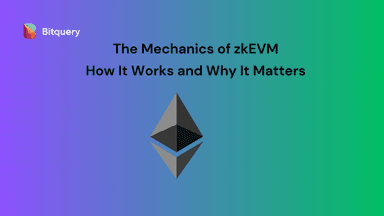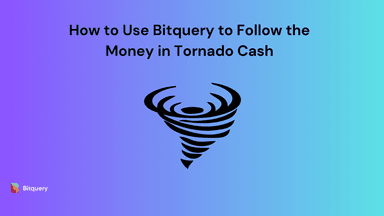
How to Conduct Blockchain Analysis for Free
Blockchain analysis is an essential technique in the web3 sector, as it focuses on deciphering the vast amount of data generated by blockchains like Bitcoin and Ethereum. By exploring these intricate data trails, blockchain analysis provides a clearer picture of the ecosystem, offering valuable insights into the evolving landscape of web3. In this blog, we will see how anyone can do Blockchain Analysis for free using Bitquery.
What is Blockchain Analysis?
Blockchain analysis is a systematic approach to understanding and interpreting data on the chain, such as Bitcoin and Ethereum. This process involves a series of steps: inspecting, cataloging, interpreting, identifying, clustering, modeling, and visually representing blockchain data. The primary aim is to extract actionable insights about the various participants in cryptocurrency transactions.
Why is Blockchain Analysis important?
By using specialized software and techniques, blockchain analysis helps in extracting crucial information, including user behaviors and transactional patterns. It plays a key role in tracing fund movements across wallets and provides a deeper understanding of the blockchain ecosystem’s dynamics, offering valuable insights into how blockchain networks function and are utilized.
Looking for end to end Crypto investigation tool? Explore Coinpath Moneyflow, built for investors and law enforcement agencies. Check it out here!
What are the Different Use Cases for Blockchain Analysis?
Blockchain analysis has a wide range of applications, each offering unique insights and benefits in various sectors:
-
Competitive Intelligence : In the growing crypto market, companies and institutions like BlackRock and Tesla invest in crypto assets. Blockchain analysis allows monitoring of competitors’ fund movements in public blockchains, providing strategic business insights.
-
Research : In academic and research fields, blockchain analytics can assess the anonymity of cryptocurrencies, usage patterns, and user demographics. It’s particularly useful for processing data with machine learning for unexpected insights.
-
Education : For data analysts and students, blockchain offers a rich dataset for hands-on learning and experience in data analysis and blockchain technology.
-
Monitoring Network Health : Blockchain analysis is used to monitor protocol adherence by miners, fee structures, and usage patterns of cryptocurrencies, providing insights into the network’s health and functionality.
-
Screening For Crypto Transaction Risk : Blockchain analytics can identify wallets linked to financial crimes like money laundering or terrorist financing, minimizing organizational risk.
-
Identify High-Risk Customers : By assigning risk scores to wallets based on their transaction history, blockchain analytics helps businesses understand and manage risks associated with illicit activities.
-
Improving SARs Submissions : Blockchain analytics aids in creating effective Suspicious Activity Reports (SARs) by identifying and grouping illicit transactions, enhancing the safety of the cryptocurrency market.
-
Obtaining Regulatory Approval : Analytics can support crypto exchanges in securing regulatory licenses by demonstrating effective anti-money laundering measures and compliance.
These use cases show the diverse potential of blockchain analysis in enhancing transparency, security, and compliance in the evolving landscape of digital currencies and blockchain technology.
How to Track Token Holdings and Ownership Concentration?
In cryptocurrency, tracking token holdings and ownership concentration involves analyzing blockchain data to assess how tokens are distributed among holders. Key steps include using blockchain explorers like Bitquery Explorer to identify significant token holders and monitoring their wallet balances and transaction histories. Aggregating and analyzing this data reveals the percentage of total supply owned by top holders, crucial for understanding market decentralization.
Why Track Token Holdings and Ownership Concentration?
Specialized blockchain analytics tools simplify tracking large wallet movements and visualizing token distributions. It’s important to distinguish between individual holders and exchange wallets, as the latter can represent pooled user funds. Regular monitoring captures dynamic changes due to market activities. The analysis helps identify risks of market manipulation or centralization, contributing to a better understanding of the cryptocurrency’s health and regulatory compliance.
How to Get Started with Bitquery?
To get started for free, please create an account here with your email: GraphQL IDE
Once created, create your first query. Join the telegram group for any doubts and support. To learn more about how to use the Bitquery API, please see the following resources:
- Historical / Near-Realtime Chain Data: Blockchain API Documentation (V1 Graphql Docs) | Blockchain Graphql API (V1 API Docs)
- Realtime Data , Websocket and Cloud Product: Blockchain Streaming API (V2 Graphql Docs) | Streaming API (V2 API Docs)
Let’s dive into on-chain insights with Bitquery APIs.
How to use Bitquery to track Token Holdings and Ownership Concentration?
Bitquery’s Token Holders API enables users to access information about token holders for both fungible (ERC20) and non-fungible (ERC721) tokens. It offers current data on token holders for specific tokens, along with their historical information.
- Total Token Holder Count: With the Token Holder API, users can retrieve the total number of token holders. By using the uniq field and obtaining unique Holder_Address values, users can determine the number of token holders on a specific date. The query below displays the token holder count for the USDT token on Ethereum on 22nd October 2023.
{
EVM(dataset: archive, network: eth) {
TokenHolders(
date: "2023-10-22"
tokenSmartContract: "0xdAC17F958D2ee523a2206206994597C13D831ec7"
where: {Balance: {Amount: {gt: "0"}}}
) {
uniq(of: Holder_Address)
}
}
}
- Count of Transactions for a Token from a Token Holder: Users can even check how frequently an address has participated in transactions with a specific token using Token Holder API. The query below displays the number of transactions involving Mutant Ape Yacht Club (MAYC NFT) from a specific wallet.
{
EVM(dataset: archive, network: eth) {
TokenHolders(
date: "2023-10-22"
tokenSmartContract: "0x60E4d786628Fea6478F785A6d7e704777c86a7c6"
limit: {count: 10}
where: {Holder: {Address: {is: "0x18f024244d0c41534c4fb77f958912f3aa403719"}}}
) {
BalanceUpdate {
transactions: Count
}
Holder {
Address
}
}
}
}
- First & Last Date of Transfer for a Token Holder: Users can also retrieve the dates of the first and most recent transactions using the Token Holder API. The query below displays first and latest transaction of Mutant Ape Yacht Club (MAYC) Token.
{
EVM(dataset: archive, network: eth) {
TokenHolders(
date: "2023-10-22"
tokenSmartContract: "0x60E4d786628Fea6478F785A6d7e704777c86a7c6"
limit: {count: 10}
where: {Holder: {Address: {is: "0x18f024244d0c41534c4fb77f958912f3aa403719"}}}
) {
BalanceUpdate {
FirstDate
LastDate
}
Holder {
Address
}
}
}
}
- Top Token Holders for a Token: Token Holders API also allows users to sort the data based on the token balance in descending order. The query below displays the top 10 token holders for the Mutant Ape Yacht Club (MAYC) NFT collection.
{
EVM(dataset: archive, network: eth) {
TokenHolders(
date: "2023-10-22"
tokenSmartContract: "0x60E4d786628Fea6478F785A6d7e704777c86a7c6"
limit: {count: 10}
orderBy: {descending: Balance_Amount}
) {
Holder {
Address
}
Balance {
Amount
}
}
}
}
- Common Token Holders of Two Tokens: Users can even know about common tokens holders of two tokens using Bitquery’s Token Holders API. The query below displays common token holders of Bored Ape Yacht Club and Mutant Ape Yacht Club NFT tokens.
{
EVM(dataset: archive) {
BalanceUpdates(
orderBy: {descendingByField: "token1"}
limit: {count: 1000}
where: {Currency: {SmartContract: {in: ["0xbc4ca0eda7647a8ab7c2061c2e118a18a936f13d", "0x60e4d786628fea6478f785a6d7e704777c86a7c6"]}}}
) {
BalanceUpdate {
Address
}
token1: sum(
of: BalanceUpdate_Amount
if: {Currency: {SmartContract: {is: "0xbc4ca0eda7647a8ab7c2061c2e118a18a936f13d"}}}
selectWhere: {gt: "0"}
)
token2: sum(
of: BalanceUpdate_Amount
if: {Currency: {SmartContract: {is: "0x60e4d786628fea6478f785a6d7e704777c86a7c6"}}}
selectWhere: {gt: "0"}
)
}
}
}
How to Track Scams and Hacks?
To track scams and hacks in web3, vigilance and the use of specific tools are key. Start by monitoring transactions for unusual activities, such as large, unexpected transfers to unknown addresses. Setting up transaction alerts for high-value or previously compromised wallets can provide early warnings. Analyzing transaction patterns helps identify typical scam behaviors, such as quickly moving funds through multiple addresses. Specialized blockchain analytics tools are also crucial for detecting anomalies and flagging potential fraud based on known scam patterns.
How to use Coinpath to track Scams and Hacks?
Coinpath®, developed by the Bitquery team, is a set of blockchain money tracing APIs designed to streamline compliance, crypto investigations, and blockchain monitoring. This functionality is essential in building crypto compliance solutions, investigation tools, and software for monitoring blockchain activities. The platform is helpful in discovering the origins, destinations, and participants involved in transactions, allowing users to detect and analyze connections between different blockchain addresses.
On November 27, 2019, Upbit, suffered a security breach resulting in the theft of approximately 342K ETH, valued at around $48.1 million, which was then transferred to a specific address. Criminals involved in such thefts often use a series of intermediate wallets and services to launder the stolen cryptocurrencies, creating complex layers of transactions that obscure the funds' original source. These layers, known as 'hops', consist of groups of wallets through which the funds are moved.
Tracing through multiple hops
Coinpath® technology is instrumental in tracing these funds across multiple hops to identify their origin or destination. The provided image illustrates how the stolen ETH was distributed across various addresses, with many receiving similar amounts (e.g., 5000 ETH) through several transactions spanning 3–5 hops, indicating potential association with the hackers. Coinpath® analyzes thousands of transactions in the background to furnish these insights.
This capability is useful in developing risk assessment systems that can identify suspicious deposits and withdrawals, a crucial aspect in the detection of scams and hacks in the web3 world. Furthermore, Coinpath® is instrumental in crypto forensics and digital asset tracking. This aspect is vital for investigations into cryptocurrency scams and hacks, where tracing the movement of funds and identifying the parties involved are key to understanding and resolving such incidents.
Conclusion
Blockchain analysis is a detailed process where specialists use specialized software to analyze blockchain data, tracking user transactions and behaviors. They look for patterns in how funds move between wallets and the relationships between different transactions. This information is vital for understanding the complexities of digital currencies and the health of blockchain platforms.
Bitquery APIs are a useful tool for anyone in the field, whether you’re a developer, trader, researcher, analyst, student, or just a curious user. They allow you to dive deeper into blockchain data and gain a better understanding of its intricacies.
About Bitquery
Bitquery is your comprehensive toolkit designed with developers in mind, simplifying blockchain data access. Our products offer practical advantages and flexibility.
-
APIs - Explore API: Easily retrieve precise real-time and historical data for over 40 blockchains using GraphQL. Seamlessly integrate blockchain data into your applications, making data-driven decisions effortless.
-
Coinpath® - Try Coinpath: Streamline compliance and crypto investigations by tracing money movements across 40+ blockchains. Gain insights for efficient decision-making.
-
Data in Cloud - Try Demo Bucket: Access indexed blockchain data cost-effectively and at scale for your data pipeline. We currently support Ethereum, BSC, Solana, with more blockchains on the horizon, simplifying your data access.
-
Explorer - Try Explorer: Discover an intuitive platform for exploring data from 40+ blockchains. Visualize data, generate queries, and integrate effortlessly into your applications.
Blog written by guest author Yash
Subscribe to our newsletter
Subscribe and never miss any updates related to our APIs, new developments & latest news etc. Our newsletter is sent once a week on Monday.


